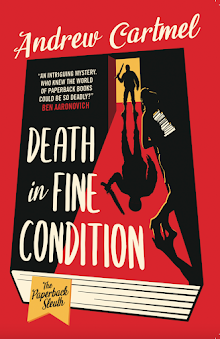 Agatha Christie is so consistently brilliant that it's actually kind of a relief to finally encounter a disappointing book by her.
Agatha Christie is so consistently brilliant that it's actually kind of a relief to finally encounter a disappointing book by her. Elephants Can Remember is the 40th Poirot adventure, published in 1972. As with Hallowe'en Party it co-stars Ariadne Oliver, indeed her name represents the first words of the book.
 Much more so than in Hallowe'en Party, Ariadne does the legwork here – I guess Poirot was entitled to have a rest, given that he was already no spring chicken when
he began investigating, back in The Mysterious Affair at Styles, over half a century earlier.
Much more so than in Hallowe'en Party, Ariadne does the legwork here – I guess Poirot was entitled to have a rest, given that he was already no spring chicken when
he began investigating, back in The Mysterious Affair at Styles, over half a century earlier. In fact we get a bit of uncharacteristic and rather melancholy modesty from the great detective when he reflects
that "many people who had heard of Hercule Poirot are now reposing with
suitable memorial stones over them."
In fact we get a bit of uncharacteristic and rather melancholy modesty from the great detective when he reflects
that "many people who had heard of Hercule Poirot are now reposing with
suitable memorial stones over them."Which shows that Christie was still capable of a witty turn of phrase.
 Ariadne brings Poirot a case, a cold case, which involves him "going
back... for murder." Go Back for Murder was the title Christie gave to the excellent stage play she adapted from Five Little Pigs, her masterpiece.
Ariadne brings Poirot a case, a cold case, which involves him "going
back... for murder." Go Back for Murder was the title Christie gave to the excellent stage play she adapted from Five Little Pigs, her masterpiece.To be exact, Inspector Garroway comments, "Monsieur Poirot, if I'm not mistaken, has occasionally shown a leaning towards looking into cases, going back, shall we say, for murder, going back into the past, twice, perhaps three times."

There then follows a discussion of Five Little Pigs (a bad mistake, I think because of the comparison it invites between that brilliant book and this decidedly weak one) Hallowe'en Party (containing quite a spoiler) and Mrs McGinty's Dead.
I'd say all of those books are better than Elephants Can Remember, which hinges on an apparent murder and suicide — or is it a suicide pact? — on a bleak cliff top involving a husband and wife.

The wife has an identical twin. Or does she? In case you think that's another hint of a fascinating twist in the story, it isn't...
The sisters are called Molly and Dolly, which leads to a bit of confusion for the reader. But that's nothing compared to Christie's evident confusion about the pair.
 At one point Dolly is described as "the more beautiful of the two" (they're identical!) while elsewhere one sister is said to be older than the other (they're twins!).
At one point Dolly is described as "the more beautiful of the two" (they're identical!) while elsewhere one sister is said to be older than the other (they're twins!).The worst thing about this old identical twins gag is that it immediately plants a suspicion in the reader's mind about what might actually have happened on that cliff top.
And I duly made my guess about the solution of the mystery. But you never guess the solution in an Agatha Christie — not correctly.

So I avidly followed Poirot's traditional monologue at the end in the comfortable and unshakable knowledge that he would pull the rug out from under me at the last instant and present a breathtakingly brilliant and quite different interpretation.
But he didn't.
The final revelation in Elephants Can Remember is, for the first time in my experience in Christie's work, dull and rather obvious.

However, I should mention that the admirable Charles Osborne in his book The Life and Crimes of Agatha Christie thinks this story "is actually an ingenious one."
And even if like me you see the ending coming a mile off, we should perhaps take account of the fact that this is a very late work by Agatha Christie.
 In fact it's the second last novel she wrote. It would be followed by Postern of Fate and then the final Poirot, Curtain, and the final Miss Marple, Sleeping Murder, both of which were written thirty years earlier and stored away like vintage wine.
In fact it's the second last novel she wrote. It would be followed by Postern of Fate and then the final Poirot, Curtain, and the final Miss Marple, Sleeping Murder, both of which were written thirty years earlier and stored away like vintage wine.  Anyway, after some 70 books and a long and dazzling career, I think she should be forgiven for a somewhat disappointing novel.
Anyway, after some 70 books and a long and dazzling career, I think she should be forgiven for a somewhat disappointing novel.How quick we should be to forgive her for the even more disappointing racial slur on page 2 of this book is another matter.
(Image credits: The main image is a scan of my own copy. The other cover designs are from Good Reads, some of them brilliantly inventive, as if to make up for the weakness of the novel itself.)




No comments:
Post a Comment